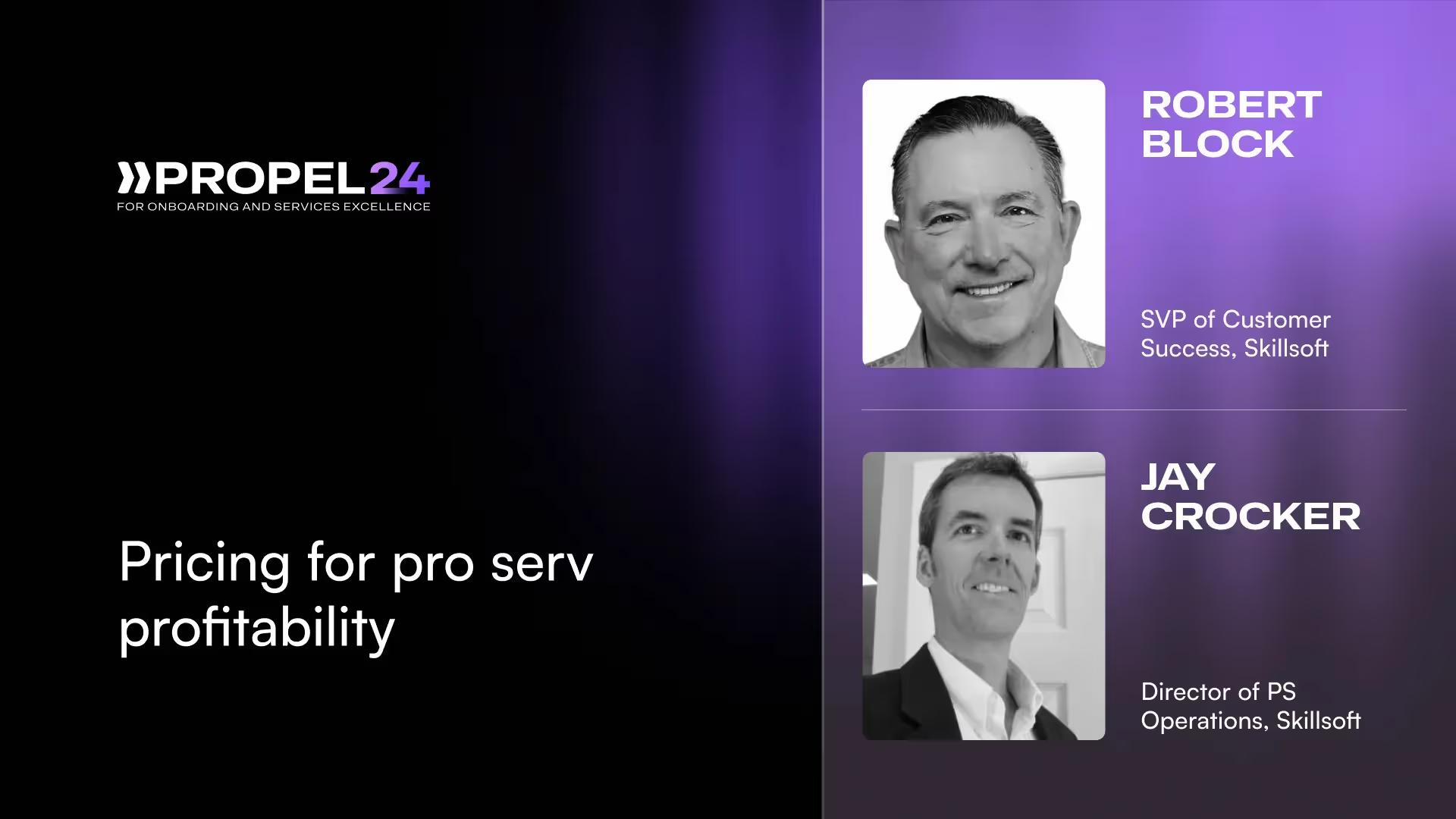Positioning professional services (PS) within your accounts in a SaaS business involves strategic thinking about both pricing and market integration. These elements are especially crucial for effective PS delivery.
At Propel24, Robert Block, Senior Vice President of Customer Success, and Jay Crocker, Director of PS Operations at Skillsoft, discussed the strategic positioning and pricing of professional services (PS) within SaaS businesses. They shared insights from their extensive industry experience and offered valuable talking points that can be applied in different contexts.
Defining and scoping professional services
When thinking about the customer journey in a SaaS context, particularly within the first year, the focus shifts from initial onboarding to achieving live status on the software and driving usage and adoption. Beyond the first year, the emphasis turns toward renewal and expansion strategies. PS plays a critical role in both phases, necessitating tailored approaches to meet the distinct needs of onboarding, adoption, and ongoing customer success.
Strategically positioning professional services (PS) within SaaS businesses requires thoughtful consideration of where to begin and how to sequence initiatives. Every leader could approach it differently, based on their experience. For example, someone who has a PS background, like Robert, would tend to prioritize building a robust PS engine first. This involves defining clear objectives for PS within the company's broader strategic framework and aligning these services closely with the customer journey.
Before getting into the specifics of acquisition strategies, onboarding processes, and post-go-live support, it's crucial to grasp the business landscape of the software company. The company's stage (pre-IPO vs. post-IPO), growth trajectory (high growth vs. low growth), and market maturity (evangelical sales cycle vs. mature market) significantly shape how PS services are packaged, priced, and perceived. This comprehensive view is instrumental in developing PS strategies that resonate with both internal stakeholders and the broader market.
Understanding how PS is perceived within its specific market segment—its role, its impact, and its value proposition—is crucial. This market-specific insight informs their ongoing efforts to mature and refine their PS offerings to meet customer needs and expectations better.
The importance of an evolving PS strategy
In the early stages of a product company's lifecycle, especially during an evangelical sales cycle, the primary goal is often product adoption rather than immediate PS monetization. As the product gains traction and achieves market fit, PS becomes instrumental in implementing the product effectively and extracting maximum value for customers. Determining the optimal PS attach rate—how much PS revenue is required per dollar of product revenue in the first year—depends on factors such as product complexity and market demand. The PS attach rate can vary from 10% to 100%
Successful PS programs often experience increasing attach rates over time as customers recognize the transformative impact of effective PS engagements. This positive feedback loop frequently leads to a surge in demand for PS services, prompting companies to consider integrating PS functionalities directly into their product offerings. This evolution signifies an integration of PS into the product lifecycle, positioning it not merely as a service but as a fundamental component of the product's value proposition and customer success strategy.

Different objectives drive the approach to PS and CS activities depending on the stage of the customer lifecycle. When considering acquisition and onboarding versus renewal and expansion phases, it's crucial to delineate these stages and tailor service offerings accordingly. A key best practice involves identifying "moments that matter." These pivotal instances, such as demonstrating the working solution or aligning the customer's business strategy with the platform, often deliver significant value despite their brevity compared to more time-intensive tasks.
Integrating both PS and CS activities is essential in developing onboarding journeys, but it can be challenging for companies unfamiliar with their respective roles. To streamline this process, defining tasks based on expertise—PS handling implementation while CS manages customer success—clarifies organizational roles and responsibilities.
Another critical consideration is time to value, a metric closely monitored in software companies. While PS teams focus on delivering comprehensive implementations efficiently, the ultimate goal is to demonstrate tangible value to customers swiftly. Some strategies involve staging multiple "go-lives" to progressively introduce platform functionalities, ensuring customers derive value early and continuously throughout the deployment process. This approach underscores the importance of balancing thorough implementation with expedited time-to-value outcomes.
Understanding Skillsoft's PS offerings
At Skillsoft, the approach to PS offerings spans customer acquisition, renewal, and growth phases, focusing on a structured framework of services. This includes strategic services aimed at defining customer success strategies, implementation services for seamless deployment, operational support to enhance administrative capabilities, and customizable programs tailored to specific customer needs. By outlining these broad categories first, Skillsoft ensures clarity in service delivery across different stages of the customer lifecycle.
Further refining these offerings, Skillsoft breaks them down into specific, prepackaged product offers designed to address distinct customer needs. Each offering is accompanied by a detailed pricing and estimation package, facilitating transparency and alignment with customer expectations. This approach streamlines service delivery and supports a structured pricing model that reflects the value delivered through PS engagements.
Once the strategic framework and target market for PS services at Skillsoft are defined, the focus shifts to developing a comprehensive pricing model that aligns with customer acquisition, renewal, and growth phases. This involves meticulous planning to ensure clarity and consistency across service offerings.
Steps for building an effective pricing model
Key considerations in formulating the pricing model include sourcing ideas for new services. You must emphasize listening closely to customer feedback and leveraging insights from the implementation team to identify emerging needs. This approach ensures that new service initiatives, such as AI skills training, are driven by market demand and strategic alignment with corporate goals.
Furthermore, staying closely attuned to the company's product roadmap is crucial. This facilitates anticipating future service requirements and ensures that PS offerings are seamlessly integrated with evolving product features.
The mechanics of creating a pricing model for PS services involves a series of structured steps to ensure consistency, repeatability, and the establishment of standards across the organization.
Here are the key focus areas for an effective pricing model:
Service delivery effort
1. Template creation
Start with a template using tools like Google Sheets or a PSA tool. This template should include a work breakdown structure with columns for hours, costs, and bill rates.
2. Expert inputs
To estimate the level of effort required across tasks, involve subject matter experts such as implementation consultants, product and engineering teams, and customer success teams.
3. Historical data
Utilize historical data to refine estimates. If available, use past project data to create a baseline and identify trends. This can provide a reference point and enhance accuracy in estimates.
Overhead and miscellaneous costs
1. Project management and support
Don’t forget to include overhead costs like project management and support services in your pricing model.
2. Internal costs
Identify the internal costs associated with different roles (e.g., strategy consultants, implementation specialists, offshore analysts). Work with the finance team to obtain accurate cost data based on roles, experience levels, and geography.
3. Additional expenses
Incorporate other necessary expenses, such as technology and travel costs, into the model.
Billing rates and margins
1. Bill rates
Establish bill rates for different services. Some organizations include bill rates in the SOW (Statement of Work) as an addendum.
2. Industry benchmarks
Use industry research and benchmarks from sources like TSIA and SPI for guidance on bill rates. Typically, these rates range from $100 to $250 depending on the industry, experience, and type of service.
3. Margin targets
Define specific margin targets to achieve at the service level. Understand what margin is expected from a top-down perspective.
Competitive analysis and pricing strategy
1. Competitor insights
Research competitors to understand how they package and price similar services. Determine if they use fixed pricing or time and materials (T&M) models.
2. Scenario testing
Use the pricing model to test different scenarios. For example, compare onshore versus offshore rates to identify pricing flexibility. Evaluate whether fixed-fee pricing is more suitable for your market compared to T&M, and include buffers for fixed-fee pricing to manage risks.
Best practices and tips
1. Importance of charging for services
- Free work is often perceived negatively, leading to lower client engagement. Charging for services ensures that clients are more invested and engaged.
- Knowing your break-even point is crucial for profitability. Even if you decide to discount or give services away for strategic reasons, understanding your numbers is essential for informed stakeholder discussions.
2. Value proposition and stakeholder engagement
- Clearly define your service's value proposition. This involves understanding why the service is important to customers and how it benefits them beyond PR considerations.
- Partner with sales and marketing teams to communicate the value proposition effectively and position the service in the market.
3. Piloting new services
- Pilot new services with select customers to gather feedback and fine-tune the offering. Collaborate with CSMs and account teams to identify suitable pilot customers.
4. System integration for tracking and feedback
- Integrate systems like Salesforce to create dynamic templates and track time and costs against projects. This integration provides a feedback loop for refining estimates and driving profitability.
5. Addressing sales team concerns
The sales team might be defensive, especially if you aim to increase the attach rate. To overcome this, build a compelling story that highlights how including PS accelerates value realization for the customer. Use data and visuals to show how incremental PS support in the initial rollout stage boosts usage and adoption rates.
6. Full lifecycle connection
Ensure a smooth transition from sales to delivery by understanding all customer-related parameters, strategies, and purchase reasons. Incorporate these insights into the PS delivery tasks and language, ensuring a seamless handover from sales to the customer success manager (CSM). Ensure a smooth transition by providing structured sign-offs and project closure processes.
{{demo}}






















.webp)